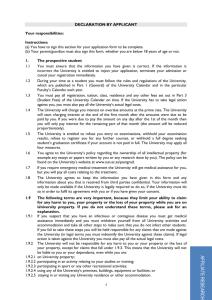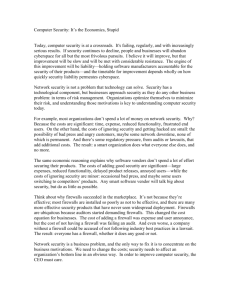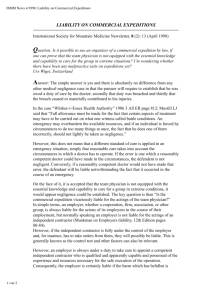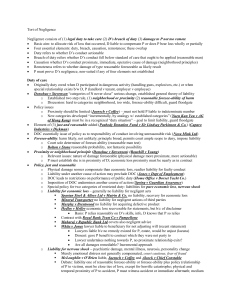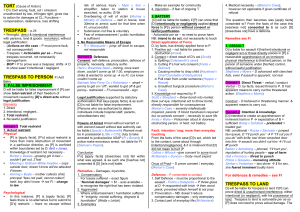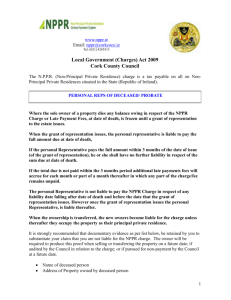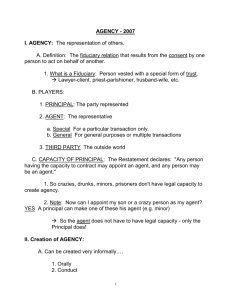Law-140-Torts-Sutherland-by-Plonka-brief-term-2
advertisement
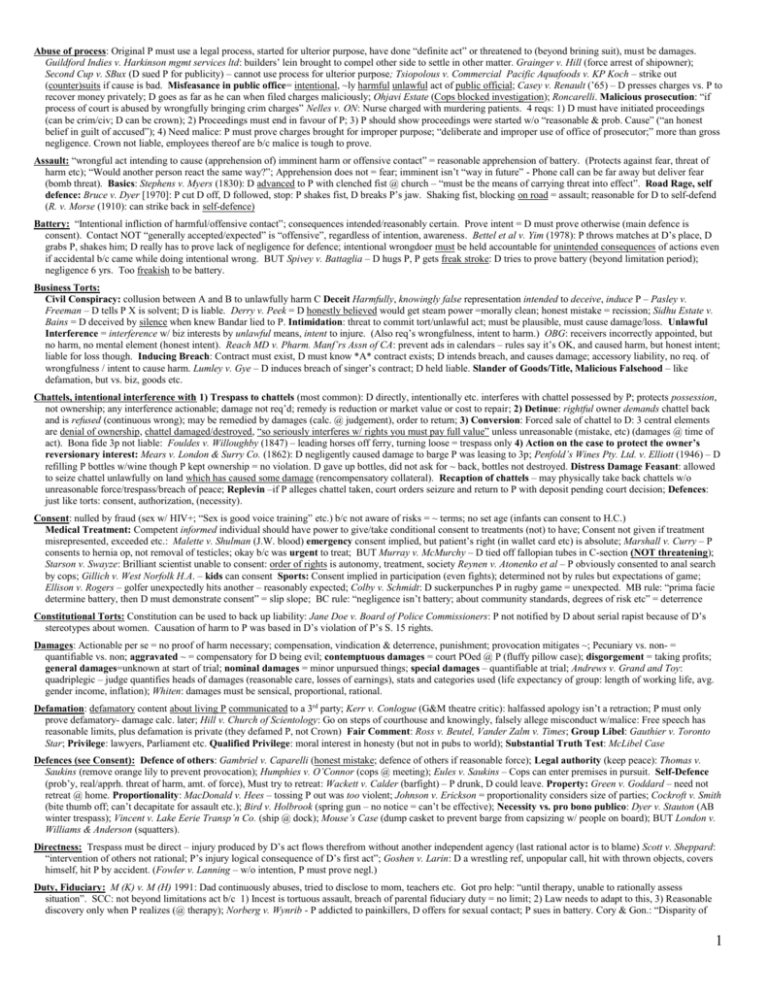
Abuse of process: Original P must use a legal process, started for ulterior purpose, have done “definite act” or threatened to (beyond brining suit), must be damages. Guildford Indies v. Harkinson mgmt services ltd: builders’ lein brought to compel other side to settle in other matter. Grainger v. Hill (force arrest of shipowner); Second Cup v. SBux (D sued P for publicity) – cannot use process for ulterior purpose; Tsiopolous v. Commercial Pacific Aquafoods v. KP Koch – strike out (counter)suits if cause is bad. Misfeasance in public office= intentional, ~ly harmful unlawful act of public official; Casey v. Renault (’65) – D presses charges vs. P to recover money privately; D goes as far as he can when filed charges maliciously; Ohjavi Estate (Cops blocked investigation); Roncarelli. Malicious prosecution: “if process of court is abused by wrongfully bringing crim charges” Nelles v. ON: Nurse charged with murdering patients. 4 reqs: 1) D must have initiated proceedings (can be crim/civ; D can be crown); 2) Proceedings must end in favour of P; 3) P should show proceedings were started w/o “reasonable & prob. Cause” (“an honest belief in guilt of accused”); 4) Need malice: P must prove charges brought for improper purpose; “deliberate and improper use of office of prosecutor;” more than gross negligence. Crown not liable, employees thereof are b/c malice is tough to prove. Assault: “wrongful act intending to cause (apprehension of) imminent harm or offensive contact” = reasonable apprehension of battery. (Protects against fear, threat of harm etc); “Would another person react the same way?”; Apprehension does not = fear; imminent isn’t “way in future” - Phone call can be far away but deliver fear (bomb threat). Basics: Stephens v. Myers (1830): D advanced to P with clenched fist @ church – “must be the means of carrying threat into effect”. Road Rage, self defence: Bruce v. Dyer [1970]: P cut D off, D followed, stop: P shakes fist, D breaks P’s jaw. Shaking fist, blocking on road = assault; reasonable for D to self-defend (R. v. Morse (1910): can strike back in self-defence) Battery: “Intentional infliction of harmful/offensive contact”; consequences intended/reasonably certain. Prove intent = D must prove otherwise (main defence is consent). Contact NOT “generally accepted/expected” is “offensive”, regardless of intention, awareness. Bettel et al v. Yim (1978): P throws matches at D’s place, D grabs P, shakes him; D really has to prove lack of negligence for defence; intentional wrongdoer must be held accountable for unintended consequences of actions even if accidental b/c came while doing intentional wrong. BUT Spivey v. Battaglia – D hugs P, P gets freak stroke: D tries to prove battery (beyond limitation period); negligence 6 yrs. Too freakish to be battery. Business Torts: Civil Conspiracy: collusion between A and B to unlawfully harm C Deceit Harmfully, knowingly false representation intended to deceive, induce P – Pasley v. Freeman – D tells P X is solvent; D is liable. Derry v. Peek = D honestly believed would get steam power =morally clean; honest mistake = recission; Sidhu Estate v. Bains = D deceived by silence when knew Bandar lied to P. Intimidation: threat to commit tort/unlawful act; must be plausible, must cause damage/loss. Unlawful Interference = interference w/ biz interests by unlawful means, intent to injure. (Also req’s wrongfulness, intent to harm.) OBG: receivers incorrectly appointed, but no harm, no mental element (honest intent). Reach MD v. Pharm. Manf’rs Assn of CA: prevent ads in calendars – rules say it’s OK, and caused harm, but honest intent; liable for loss though. Inducing Breach: Contract must exist, D must know *A* contract exists; D intends breach, and causes damage; accessory liability, no req. of wrongfulness / intent to cause harm. Lumley v. Gye – D induces breach of singer’s contract; D held liable. Slander of Goods/Title, Malicious Falsehood – like defamation, but vs. biz, goods etc. Chattels, intentional interference with 1) Trespass to chattels (most common): D directly, intentionally etc. interferes with chattel possessed by P; protects possession, not ownership; any interference actionable; damage not req’d; remedy is reduction or market value or cost to repair; 2) Detinue: rightful owner demands chattel back and is refused (continuous wrong); may be remedied by damages (calc. @ judgement), order to return; 3) Conversion: Forced sale of chattel to D: 3 central elements are denial of ownership, chattel damaged/destroyed, “so seriously interferes w/ rights you must pay full value” unless unreasonable (mistake, etc) (damages @ time of act). Bona fide 3p not liable: Fouldes v. Willoughby (1847) – leading horses off ferry, turning loose = trespass only 4) Action on the case to protect the owner’s reversionary interest: Mears v. London & Surry Co. (1862): D negligently caused damage to barge P was leasing to 3p; Penfold’s Wines Pty. Ltd. v. Elliott (1946) – D refilling P bottles w/wine though P kept ownership = no violation. D gave up bottles, did not ask for ~ back, bottles not destroyed. Distress Damage Feasant: allowed to seize chattel unlawfully on land which has caused some damage (rencompensatory collateral). Recaption of chattels – may physically take back chattels w/o unreasonable force/trespass/breach of peace; Replevin –if P alleges chattel taken, court orders seizure and return to P with deposit pending court decision; Defences: just like torts: consent, authorization, (necessity). Consent: nulled by fraud (sex w/ HIV+; “Sex is good voice training” etc.) b/c not aware of risks = ~ terms; no set age (infants can consent to H.C.) Medical Treatment: Competent informed individual should have power to give/take conditional consent to treatments (not) to have; Consent not given if treatment misrepresented, exceeded etc.: Malette v. Shulman (J.W. blood) emergency consent implied, but patient’s right (in wallet card etc) is absolute; Marshall v. Curry – P consents to hernia op, not removal of testicles; okay b/c was urgent to treat; BUT Murray v. McMurchy – D tied off fallopian tubes in C-section (NOT threatening); Starson v. Swayze: Brilliant scientist unable to consent: order of rights is autonomy, treatment, society Reynen v. Atonenko et al – P obviously consented to anal search by cops; Gillich v. West Norfolk H.A. – kids can consent Sports: Consent implied in participation (even fights); determined not by rules but expectations of game; Ellison v. Rogers – golfer unexpectedly hits another – reasonably expected; Colby v. Schmidt: D suckerpunches P in rugby game = unexpected. MB rule: “prima facie determine battery, then D must demonstrate consent” = slip slope; BC rule: “negligence isn’t battery; about community standards, degrees of risk etc” = deterrence Constitutional Torts: Constitution can be used to back up liability: Jane Doe v. Board of Police Commissioners: P not notified by D about serial rapist because of D’s stereotypes about women. Causation of harm to P was based in D’s violation of P’s S. 15 rights. Damages: Actionable per se = no proof of harm necessary; compensation, vindication & deterrence, punishment; provocation mitigates ~; Pecuniary vs. non- = quantifiable vs. non; aggravated ~ = compensatory for D being evil; contemptuous damages = court POed @ P (fluffy pillow case); disgorgement = taking profits; general damages=unknown at start of trial; nominal damages = minor unpursued things; special damages – quantifiable at trial; Andrews v. Grand and Toy: quadriplegic – judge quantifies heads of damages (reasonable care, losses of earnings), stats and categories used (life expectancy of group: length of working life, avg. gender income, inflation); Whiten: damages must be sensical, proportional, rational. Defamation: defamatory content about living P communicated to a 3rd party; Kerr v. Conlogue (G&M theatre critic): halfassed apology isn’t a retraction; P must only prove defamatory- damage calc. later; Hill v. Church of Scientology: Go on steps of courthouse and knowingly, falsely allege misconduct w/malice: Free speech has reasonable limits, plus defamation is private (they defamed P, not Crown) Fair Comment: Ross v. Beutel, Vander Zalm v. Times; Group Libel: Gauthier v. Toronto Star; Privilege: lawyers, Parliament etc. Qualified Privilege: moral interest in honesty (but not in pubs to world); Substantial Truth Test: McLibel Case Defences (see Consent): Defence of others: Gambriel v. Caparelli (honest mistake; defence of others if reasonable force); Legal authority (keep peace): Thomas v. Saukins (remove orange lily to prevent provocation); Humphies v. O’Connor (cops @ meeting); Eules v. Saukins – Cops can enter premises in pursuit. Self-Defence (prob’y, real/apprh. threat of harm, amt. of force), Must try to retreat: Wackett v. Calder (barfight) – P drunk, D could leave. Property: Green v. Goddard – need not retreat @ home. Proportionality: MacDonald v. Hees – tossing P out was too violent; Johnson v. Erickson = proportionality considers size of parties; Cockroft v. Smith (bite thumb off; can’t decapitate for assault etc.); Bird v. Holbrook (spring gun – no notice = can’t be effective); Necessity vs. pro bono publico: Dyer v. Stauton (AB winter trespass); Vincent v. Lake Eerie Transp’n Co. (ship @ dock); Mouse’s Case (dump casket to prevent barge from capsizing w/ people on board); BUT London v. Williams & Anderson (squatters). Directness: Trespass must be direct – injury produced by D’s act flows therefrom without another independent agency (last rational actor is to blame) Scott v. Sheppard: “intervention of others not rational; P’s injury logical consequence of D’s first act”; Goshen v. Larin: D a wrestling ref, unpopular call, hit with thrown objects, covers himself, hit P by accident. (Fowler v. Lanning – w/o intention, P must prove negl.) Duty, Fiduciary: M (K) v. M (H) 1991: Dad continuously abuses, tried to disclose to mom, teachers etc. Got pro help: “until therapy, unable to rationally assess situation”. SCC: not beyond limitations act b/c 1) Incest is tortuous assault, breach of parental fiduciary duty = no limit; 2) Law needs to adapt to this, 3) Reasonable discovery only when P realizes (@ therapy); Norberg v. Wynrib - P addicted to painkillers, D offers for sexual contact; P sues in battery. Cory & Gon.: “Disparity of 1 power in positions; D didn’t try to help P”; H’H-D & McL: “D violated sacred medical fiduciary duty”; Sop: “P did consent, Dr-Patient rel’p present but D did not treat P” Must not infantilize addicts Economic Loss: Defective Products: danger is key. Winnipeg Condo Corp v. Bird Construction (SCC 1995): D liable for building crappy, dangerous condo. P gets costs for repairing/rectifying danger. Throw book at D for policy reasons; not indeterminate class/duty etc b/c can foresee anyone who owns/lives in your building subsequently is going to get hurt Negligent Misrepresentation: Hedley Byrne v. Heller: P phoned D asking about X’s credit. D about to close major deals w/ X, lied with waiver. P relied, X bankrupt, P sued. Relationship between the parties was “sufficiently proximate”, D knew P would rely, BUT D okay b/c info had disclaimer (see Derry v. Peek) Queen v. Cognos Inc [1993 SCC]: P suing D over negligent misrepresentations made during job interview. Hedley inspires these requirements: 1) Must have duty of care (foreseeability of damage, proximity of rel’p, reasonableness of duty) 2) Representation must be “untrue, inaccurate, or misleading” 3) Representor must have acted negligently 4) Representee must have relied … 5) … to his detriment. Hercules Management Ltd v. Ernst & Young [1997 SCC]: P shareholders, relied on D’s audits for investment decisions. SCC says liability too indeterminate; reliance must be reasonable, use info for its intended purpose. Test for reasonableness: 1) D had direct/indirect financial interest? 2) D was a professional or had extraordinary skill/knowledge etc 3) Advice given via business 4) Info given deliberately (outside social occasion) 5) Info given in response to a specific inquiry Negligent performance BDC Ltd v. Hofstrand Farms [1986 SCC]: P a courier delivering a grant for D to be reg’d before 1977. Fail = D loses = sues P. SC: P didn’t know, and “anyone who might be affected by a failure to register” is not a limited class; no reasonable contemplation of econ loss. BUT Whittingham v. Crease & Co (1977 BCSC): lawyer fucks up will, P gets fucked. P fucks lawyer in court because while P didn’t “rely” per se (no subsequent act) it’s obvious that negligent performance of legal services will fuck P. Relational Loss: Bow Valley Husky v. St. John Shipbuilding [SCC 1997]: P got D to build an oil rig. Negligent wiring caused electrical fire, fucking over rig for months. D wants (and gets) compensation for this, but third parties fucked. Relational econ loss only recoverable in certain circumstances, incl. a) Claimant has proprietary interest in the property b) “general average cases” (?) c) Joint venture between claimant and property owner. Emotional Harm, intentional infliction of (mental suffering etc) Must be intentional, must cause severe reaction; do not have to prove harm (trespass = subsequent harm); 1 or many acts, group or alone. Wilkinson v. Dowton: D scares P, P freaks out: “He wanted her to flip, violated right to security – doesn’t matter if she goes nuts”; Janvier v. Sweeney – P entitled to damages for shock of lie that husband was Ger spy; Timmermans v. Buelow: D (landlord) tries to kick P out by intimidating, knows P likely to have an attack; tension etc = P hospitalized. “D wanted this, is liable”; “knowing about condition is worse.” False imprisonment: involuntary trespass to the person, confinement must be total, escape must be reasonable, must be direct act of D, D must prove it’s reasonable. Escape: Bird v. Jones (bridge closed – walk around!); Bonner v. Manwest Hotel: P reasonably refuses to pay for wine; cop gives him bs charge = falsely imprisoned. Not enough that P could’ve bolted out back door; Knowledge: Meering v. Grahame White Aviation: can be falsely imprisoned w/o knowing – insanity, sleeping, etc; Martin v. Berrends: can be held liable if cops falsely arrest on your say-so. Prisoners: Martin v. Houck; Hill v. BC (prisoner put in solitary) –falsely imprisoned by removing freedoms. Psych imprisonment: Campbell v. SS Kresge Co. – cop could falsely imprison just by pulling badge; Chaytor et al v. London NY Paris Assn’t of Fashion (NF)– comparison shopping, must ask to leave. Resisting Arrest: Koechlin v. Waugh; Christie & Another v. Leachinsky: OK if no grounds for arrest, if not informed of reasons, etc. Voluntariness: Martin v. Berrends – bus riding voluntary + not urgent; BUT removal of consent generally = imprisonment Intent (see TRESPASS): Actor intends consequences OR is reasonably certain of ~ (even if don’t care) Garrett v. Dailey – 5yo pulls out chair – lack of intent irrelevant; clear P would sit = neg.; Intent, transferred (when a different person is targeted and a different tort ensues): Carnes v. Thompson (redneck case) – A tries to evict B & C, tries to hit B with pliers but hits C = liable; Dahlberg v. Naudiuk: hunter accidentally shoots farmer, must justify shooting towards farm. Liability (see CONSENT, DAMAGES): Based on moral culpability; convenience of administration; history; capacity to bear loss; deterrence / punishment / compensation / appeasement; requires link between action and harm. Reverse Onus Rule: (fairer for P, applies to all torts) Cook & Lewis (hunting accident) – P must only prove battery, then D must prove he was not negligent. Privacy: actionable without damage. “Right to be left alone” incl. intrusions into diaries, personal info, surveillance, etc. Motherwell v. Motherwell: D calling P 50 times a day = invasion of privacy b/c interference with P’s enjoyment of normal necessities of life. Silber v. BCTV Broadcasting System Ltd: Strike at P company, D filming, P asks them to leave, and later sees them filming on his property; fight breaks out and D broadcasts it. P not entitled to protection from embarrassment because he did it in public where anyone could see it, plus media have public interest role. P gets small $ for trespass. Davis v. MacArthur: wife moves out and hires P.I. to spy on husband. Husband pissed because he’s being followed. Privacy actionable w/o damage, but P.I. acting as employee, and not maliciously. Lee v. Jacobson: D liable for drilling hole in wall. Milton (?): P vacationing in Hawaii, has topless photos taken on beach, leaves photos in jacket she borrows there. Friend shows them around, courts say it’s tough for her. P was careless and had no concern development. Commercial exploitation: “unauthorized use of another person’s name/likeness as a symbol of that person’s identity. Unauthorized Use = including portrait, anything resembling P. Action ends with P death. Joseph v. Daniels: D used P pictures for publicity photos; P didn’t sign release but got $50; P tried to contact D to obtain release after photo got lots of attention; negative implied rights re photo use, but P not identified in photo (not a portrait etc) = entitled to $550 (going rate for “extra usage”). Public Liability: standard of care may be different; may be statutory exemptions. Often linked with misfeasance, vicarious liability. Public authorities cannot be held liable for policy decisions (nonfeasance) but MAY be liable for operational decisions (misfeasance) once they assume a duty (Kamloops principle). Just v. BC [1989 SCC]: boulder falls on P’s car, killing daughter. Governments are allowed to make policy choices, but once they do (like hwy maintenance, rock control), they must do them properly. (Distinction between policy and operational decisions). Swinamer v. Nova Scotia (?? SCC): Tree falls on to P’s truck. 200 trees – not this one – marked for removal. Deciding which trees to prioritize for removal is a policy decision. Swanson and Peever v. Canada (1991 Fed CA): not banning bad pilot is operational. Sexual harassment: any sexual practice which endangers employment prospects, regularly affects workplace performance; unions have own ADR Trespass (Individual): (trespass vi et armis) Elements are intent, directness, causation, harm (not necessary to prove damage – actionable per se) Tillander v. Gosselin: ~3 yo drags baby for ~100m = brain damage – Can only be trespass b/c no right to touch infant; “no action will lie in trespass if the act is not wrongful either through wilfulness or of negligence.” – lack of intent is being 3. Lawson v. Wellesley Hospital (1975): P (visitor) sues D b/c injured by loose mental patient. Dubin: “Tortuous assaults req. vol. act – mentally ill unable to form intent = no liability”. Squitters v. de Santis (1976): D not guilty of crim murder, but civilly liable – appreciated consequences of actions = liable. Gerigs v. Rose 1979 – “‘consequence’ does not refer to moral agent of act – knowing something wrong does not = appreciating consequences. I de S & Wife v. W. de S. (1348) – trespass even if no physical harm Trespass (Land): actionable per se; nonconsensual interference with owner’s rights to possession, usually when D enters P land without permission; meant to ensure peace. Defence of property: Green v. Goddard = violence ok if ~ entry, and/or refusal to leave. Intent: Smith v. Stone (1647): Others carrying D to trespass /= D trespassing b/c no volition/intent. Mistake: Basely v. Clarkson 1681 – D accidentally cuts grass = intentional trespass; Costello v. Calgary: D expropriates land, = trespass when later decl. illegal: “Trespass occurs regardless of consciousness of wrongdoing.” Occupation: Cooper v. Crabtree: L.Lord bringing action vs. tenant – P has no right to possession. Epstein v. Cressey Development: rods under soil. Public Areas: Cttee for Com’wlth of CA: leaflets in Dorval ok b/c Dorval is public, plus Charter; Harrison v. Carswell (MB): picket in mall: trespass happen when asked by “occupier” to leave and refuse to do so; possession based on right to control entry (“privileged visitors”), plus statute. Wildwood Mall v. Stevens (SK): D friendly union goon distributing lit OK; no statute, plus invite world relinquishes control; private area can have public character. Trees: Anderson & Skander: trees natural = nuisance, not trespass; you can only cut overhangs on your property; are entitled to apples etc. if over your property line; Ford v. Zelman – killed tree - $10k punishment; Remedies: Judicial (Damages, Injunction (prohibitive, mandatory), Declaration, specific restitution) vs. Extrajudicial (recapture of chattels; reentry on to land; abatement of nuisance) (self-help) 2 NEGLIGENCE Step 1) Damage? Incl. econ loss, physical harm, loss of enjoyment etc Step 2) Does D owe a Duty of Care to P? Worry about duties to indeterminate class for ~ time etc. A) Is it a Recognized Duty of Care? Relationships of… 1) Control or Supervision (Galaske v. O’Donnell: D liable for dad and kid passengers in car.) 2) Creation of danger: Oak v. White Transport: D knocks down sign with car, sign impales another driver. D did create danger but not liable b/c sign was off the road = no immediate risk. 3) Economic Benefit Jordan House Ltd. v. Mennow and Honsberger: M a known drunk, gets drunk, kicked out on to hwy. Picked up, put home, staggers into hwy and hit by car. P liable. 4) Statutory Duties: Bonnie Mooney; Jane Doe etc. 5) Reliance: Kamloops, “lighthouse cases” etc; Mercer: normally lock a gate where the train goes past, people know this. P knows this, goes out, gets hit. D liable because he assumed a liability by his goodwill. B) Is it a new Duty of Care? Cooper v. Hobart [2001 SCR]: Mortgage Broker registrar not liable for failing to warn investors of fraud. No proximity, bad policy. Cooper Test: 1) a) Was the harm foreseeable? b) Was D sufficiently proximate to P? 2) Any policy consideration? Anns: D liable for negligent inspection of P’s buildings during construction: D assumed liability by inspecting: Anns Test (PeePee test): 1) Proximity between parties to create prima facie duty? 2) Any Policy reason not to have it? C) Is P foreseeable? (see REMOTENESS): Hay v. Young: V getting off bus, motorcyclist illegally passes, hits her, both killed; P sees this and blood afterwards: flips out, has a stillbirth. Deceased owed no duty of care to P because P not foreseeable. (Diss: “you owe a duty of care to the world at large!”). BUT Farrugia v. Great Western Rwy: D overloads truck, P chasing truck to try and stow away, box falls on, kills P. P’s illegal act irrelevant: D could’ve foreseen someone behind the truck. Step 3) Standard of Care? Extent to which you owe a duty of care: PLOC: Probability: Is harm likely enough to prevent? Bolton v. Stone: D hits cricket ball, which hits P. Only 6 instances in 30 years did a ball go into deserted hwy; small potential harm. Loss: Great potential loss = must prevent even slight risks: Paris v. Stepney Borough Council: one-eyed man blinded by chip of metal. Employer is liable for not having provided goggles. Maj. said magnitude of loss was greater (P blind); diss based on equal risk w/others. Object: Reason for incurring risk? Watt v. Hertfordshire County Council: FDP doesn’t have proper truck to carry a jack; make do; jack slips, hurts P. OK b/c public duty, saving lives. Cost: Cost of removing the risk? If it is small (e.g. seatbelts ), it should be assumed. Shilson v. Ontario Light and Power: 12 year old boy injured by electrical wire walking across ravine on 12-inch pipe after warning signs. D not liable: cost of definitely preventing adventurous boys from harm is huge. Hoster v. Toronto Electric Light Co: P touches uninsulated wire 14 inches from passenger bridge. Cost is small, risk is huge. Step 4) Reasonable Person: What kind of standard of care do we expect from D? Objective: generally careful man on the Clapham omnibus. Vaughan v. Menlowe (1837): D left up a big stack of dry hay (fire hazard) , said he “would chance it”; burns down D and P buildings. D conduct below reasonable person standard. Children: “reasonable child” based on individual age, intelligence, experience etc: McEllistrum v. Etches: 6 y.o. liable for contributory negl. on hwy b/c of particular familiarity with hwy. Heisler v. Moke: kid warned against jumping but jumps and causes injury to P; age of 7 is general age of responsibility but depends on circumstances; D is 9 and bright, is liable. Dellwo v. Pearson: Adult activity = kids assume adult standard. Custom: Depends on custom, issue, community: Waldick v. Malcom: even if custom is not to ice steps, this is negligent custom. D liable. Brown v. Rolls Royce: D didn’t supply barrier cream to employees as customary; P gets dermatitis. B/C harm not linked to breach of custom, D not liable. Disabled: Only liable based on awareness, nature of disability. Fiala v. Checkmanek (2001 AB): M goes for run, has first bipolar incident, jumps on D’s car, hits D, D hits accelerator and then P. Symptoms unforeseen = M not liable. Lawyers: Brenner v. Gregory / Winrob v. Street: lawyers not negligent if not looking at or surveying property lines. Medical: Emphasis on scientific evidence, causation; standard of reasonably prudent doctor with same skillset: Challand v. Bell (1950s AB): P needed amputation after D treated P arm; D ok b/c did what even more skilled Dr. would have. TerNeuzen v. Korn: P gets HIV from artificial insemination in 1985, before any evidence HIV could be transferred thus = D not negligent. Parents: responsible for certain things (feeding kids etc) and basing decisions on individual kids’ natures. Professional Negligence: Based on ordinary standards of that profession, area of practice etc. Statutory Standards: No “statutory breach” tort; only relevant if causal; can be cited as evidence. R in Right of Canada v. Saskatchewan Wheat Pool (1993 SCC): D violated statutory duty not to deliver infested wheat, but OK b/c no evidence of negligence. Gorris v. Scott: Sheep washed overboard; D not liable b/c statute is re spread of disease. Cannot prove B by breach of A. Ryan v. Victoria (1990s SCC): adhering to statutory standards is only minimum, /= proof of non-negl. Step 5) Causation: Did damage ensue from breach of Duty or Standard of Care? TEST 1: “But-for test”. “This harm would’ve happened but for D’s conduct” Usually works, except in cases of scientifically unprovable circumstances; multiple or repeated causes. TEST 2: Res Ipsa Loquitur: “the thing speaks for itself” (Outdated); use common sense (Snell v. Farrell). Bird v. Vogel: Barrel of flour falls from D window on to P: pretty obvious it’s D’s negligent fault. TEST 3: Material Contribution: Athey v. Leonati: P (many back problems) in 2 MVAs. Unfair to make P prove which D caused his herniated disc; P just needs to prove D materially contributed to harm. Test 4: Materially Increased Risk McGhee v. National Coal Board: ditto: P need only prove working conditions ↑ risk beyond de minimis. Step 6) Remoteness: Was the damage unforeseeable / too far removed? All about foreseeable type of damage A) Is Type of damage too remote? Wagon Mound 1: D not liable for continuing welding after oil spill b/c scientists said oil spills in water were safe. Canadian version: R. v. Coté (1974 SCC): if class of damage foreseeable, circumstances of ~ are irrelevant. Hughes v. Lord Advocate [1963]: D workers liable for failing to secure open manhole surrounded by lamps. Freak accident, but should have foreseen P (kids) would have fucked around, burned, fallen. Assiniboine S. Sch. Dist. v. Hoffer and Gr. Wpg. Gas Co (1970 SCC): Dad modifies skidaddler so son can start it easier. Son plows into school, hits gas company line = explosion. Kid and dad 25% liable, gas co 50%. Foreseeable that gas pipes would be damaged outside school B) Is possibility of type of damage at issue? Impossible = not foreseeable. Wagon Mound 1 vs. Wagon Mound 2: 2 has same basic scenario as 1. D knew risk was possible from WM1. Test is “what is possible and not what is probable”. C) Thin Skull?: If the type of harm is foreseeable, V’s reaction is your problem. Smith v. Leech Brain & Co [1962] QB: P’s husband gets burned with molten metal, causing cancer. D liable b/c burns foreseeable. Malcom v. Broadhurst [1970 QB]: husband and wife injured in car accident. H becomes violent, bad tempered. W gets upset. D liable for both thin skull victims. Marconato v. Franklin [1974] BCSC: P slightly injured in car accident, becomes depressed, hostile, paranoid etc. D liable b/c psych harm was foreseeable from negl. accident. D) i) Did Novus actus interveniens (Intervening Act) cause harm? Yes= any D negligence is eliminated / greatly reduced. Spagnolo v. Margesson’s Sports Ltd. (1983 ONCA) : D leaves car with keys in ignition, stolen, and six days later he crashes with P. Trial: foreseeable etc, especially with stats, and the rush of stealing a car. CA: “Yes, but this was six days later; how did this greater risk than you’d suffer from any normal driver?” Palsgraf v. Long Island RR Co [1928 NYCA] Train leaving, 2 X chasing train get pushed by D employees to board the train. One X has suitcase with fireworks = drops = explodes = rattles the platform = scale falls on P at the other end of platform. Maj: unanticipable, too remote, X are intervening agents. Harris v. TTC and Miller [1967 SCC]: P sticks arm out of bus, hurts it when bus pulls away. Maj: this is what kids do. A sign telling them not to is not enough. Kids not independent. Stansbie v. Troman [1948 UKCA]: D liable when he leaves w/o locking door and thief steals stuff. Obviously foreseeable, directly flowing etc. D) ii) Intervening Act from recurring situation? Intervening act generally foreseeable, esp. w/ rescuers Horsley et al v. MacLaren et al (The Ogopogo) (1972 SCC): D operating boat, M falls overboard. D fucks up rescue procedure = H jumps in. M & H die. Maj: no duty to rescue fellow passengers; situation of peril was created by M falling in; D fuckups were errors in judgment. Diss: D liable as boater for creating risk. Good Samaritans totally foreseeable. Seymour v. Winnipeg Electric Ry (1910 MBCA): “we should know humanity is good and will jump to rescue.” D) iii) Was intervening act intermediate inspection? If you knew about fault but didn’t warn inspector, you remain liable. If you didn’t know and the inspector fucked up, they’re responsible. Ives v. Clare Bros [1971 ONHC]: D makes gas furnace used by gas company X; D aware of problem. 3 inspections from X find nothing. D makes no warning. Both D and X liable. Viridian Inc. v. Dresser Canada (2002 ABCA): X sells D general diaphragms. D puts them into high pressure compressors, sells to P. Diaphragms not meant for this; explode. X not liable because b/c D had to test/inspect. X could not foresee misuse E) Does second accident stem from first? Liability for second second generally linked to first unless linked to P’s negligence. Wieland v. Cyril Lord Carpets [1969 QB]: P in accident = couldn’t have bifocals = couldn’t exercise normal care when descending stairs with help. This is linked, D liable. McKew v. Holland et al [1969 HL]: P’s leg hurt in accident. Leg gives way and he falls down stairs, jumps to fix landing, gets a way worse injury. HL: “D not liable for P’s negligent fall.” Lucas v. Juneau (Alaska 1955): D negligent in injuring P, then when transporting P, ambulance driver has epileptic fit. Both are linked, D liable. Patten v. Silberschein [1936 BCSC]: D liable for being robbed after being rendered unconscious in accident thanks to D. F) Product warning? Don’t have to warn for the obvious, but need fair warning about non-obvious dangers: DeShane v. Deere & Co (1993 ONCA): P falls into unguarded harvester machine. No duty to warn because of obvious risk. Rozenhard v. Skier’s Sport Shop (2003 AB:P): Obvious that falling is a danger of rollerblades. “Continuing duty to warn” if you discover danger later Rivtow Marine v. Wash. Iron Works (1973 SCC): D fails to warn P about defective crane after they learning about defect. D owes P. “Learned intermediary” needs full info from manufacturer to best explain to patient. Hollis v. Dow Corning 3 Corp [1995 SCC]: P gets breast implants 1983, which rupture 1985. D knew about the risk in 1979, but Dr. got “little” warning: only D, not Dr., liable. Buchan v. Ortho Pharm. Ltd. (Y?) ONCA: this rule n/a re oral contraceptives. Step 7) Defences: Contributory negligence (Recognized by Negl. Acts): P can 1) Contribute to the accident; 2) Expose self to risk, 3) Fail to take reasonable precautions. Bell Canada v. Cope (Sarnia) (1980 ONCA): P is 2/3 responsible for D cutting wire b/c P negligently places it; Speed and Speed ltd. v. Finance America Realty (1979 NSCA): contributory negligence applies to breach of contract, any “fault” Due Diligence: Comes in at the standard of care phase. If you need a defence, you’re already fucked. Illegality: ex turpi causa non oritur actio : basically, thieves shouldn’t benefit from being thieves Hall v. Hebert [1993 SCC]: P and D drinking. Car stalls, D pushing, P at wheel loses control, gets serious head injuries. McL: Ex turpi is really about preventing causes of action in criminal enterprises (IE robbers getting stiffed and suing for fraud), not re situations like this w/o profit from illegality. Seatbelt Defence: If P failed “to take a step [P] knows or ought to know to be reasonably necessary for his own safety” Gagnon v. Beaulieu [1977 BCSC], he can be held generally up to 25% liable. Galaske v. O’Donnell: kid and dad did not buckle in D’s car = cont. negl. despite D owing duty of care. Genik v. Ewanylo (1980 MBCA): does depend on circumstances. (Few blocks vs. wrong trip) Voluntary assumption of risk: volenti non fit injuria: “you’re a grownup and can do what you want” –J. Blom. Virtually gone thanks to statutes, cases. Lagasse et al v. Rural Municipality of Ritchot et al (1973) MBQB: P’s dead husband plowing snow on lake w/tractor at D’s request; tractor falls through ice. Not volenti b/c deceased did not expressly consent. Hambley v. Shepley ONCA 1967: P a cop, instructed on radio to block D with his cruiser. Collision, P seriously hurt. Volenti doesn’t apply b/c P had a duty to do this, did not expressly waive. Hagerman v. Niagara Falls (1980) ONSC: P spectator hit in eye with puck at hockey game. P sat there = Volenti. Step 8) Liability: Apportioned equally if no other way to decide on a percentage Joint Liability: Each D is 100% liable for full amount, but P gets no more than 100%. No need for concurrent actions. Several Liability: P can collect 100%, but each D is only liable for his portion. Joint and Several Liability Makes sure P gets something. P may collect 100% from A, who is only 20% responsible, and A has to sue B 80%. Requires concurrent actions; encourages frivolous litigation (incentive to include as many rich D as possible.) Leaky Condos: other defendants go bankrupt, so City of Delta’s holding the bag. BC Ferries Agreement: If you settle for $X, nobody can come after you for more than $X. Strict Liability 1) Animals For ferae naturae (dangerous, like lions), strict liability; mansuetae naturae (possibly dangerous, like dogs), “every dog is entitled one bite” before owner should restrain. Animals must be in D’s control for D to be liable. Sgro v. Verbeek (1980 OnHCJ): D’s German shepherd bit P’s kid; had never bitten anyone and only barked and run at strangers = D not liable. 2) Fires Generally strict liability; generally a non-natural use of land. 3) Products Liability strict liability if there are foreseeable dangers, duty, and reliance: Escola v. Coca Cola (1944 Cali SC): D strictly liable for exploding Coke bottle 4) The Rule of Rylands and Fletcher: strictly liable for consequences of non-natural use of land. Rylands and Fletcher (1868 HL): D dead mines underneath reservoir constructed by P; mines flooded. P liable for creating unnatural risk, liable for natural consequences. Sic uti suo ut non laedat alienum: do no harm to your neighbor. Requires A) Unnatural Use of Land: Tock v. St. John’s Metro Area Bd. [1989 SCR] Facts: D’s sewer overflows, floods P’s basement. Plumbing (and sewers) are normal modern use of land (but D loses on this as nuisance). Rickards v. Lothian [1913 AC PC]: D has toilet / basin on 4th floor, water leaks into P’s stock. P loses b/c no negl., toilets are modern use. B) Escape: Something needs to “escape” for its causation of harm to be actionable. Rigby v. Chief Constable of Northamptonshire [1985 QB]: cop fires gas canister into store, causes fire: “I see no difference between allowing a man-eating tiger to escape from your land … and … from the back of your wagon.” Hunter v. Canary Wharf [1997 AC HL]: P says D construction interferes with TV reception and creates dust. On TV reception, House of Lords tells P to suck it up: nothing escapes from the building. Read v. J. Lyons & Co Ltd. [1947 HL AC]: ammo factories completely natural use of land in wartime. Danku v. Town of Fort Frances (1976 OR): Private trailer park liable for broken sewer system; town is NOT. C) Defences to Rylands: Act of God: Rare, full excuse. Nichols v. Marsland (1876 UK CA): Unprecedented rainstorm flooded D dams, swept away P bridges. No way to anticipate, D okay. Consent, even implied, means D not liable Pattison v. PERCA (1984 ONCA): P impliedly consents to sprinkler systems via occupation = no liability for non-negligent sprinkler damage. Contributory negligence P can’t collect if he helps it. Dunn v. Birmingham Canal (1968 HL): P denied compensation for carelessly flooding his own mine under D canal. Deliberate Acts of Third Parties: 3rd party actions must intentionally cause damage and cannot just be “intentional” per se. Rickards v. Lothian [1913 AC PC]: D has toilet and basin on fourth floor, water leaks b/c 3rd party blocked pipe by accident. Legislative Authority Diversified Holdings Ltd. v. R in Right of British Columbia (1982 BCCA): D’s program to feed elk near P’s property caused increase in population; when program was cancelled, they damaged P’s crops and property. D has statutory immunity. Nusiance: 1) land-related; 2) must prove special damages if you have no interest in the land being violated. Private Nuisance: Need significant interference with occupier’s use and enjoyment of property. No defense if… P came to nuisance; nuisance beneficial to public, causes minimal harm, all possible care taken, etc. BUT can consider 1) Reasonableness of use; 2) Character of the locality, and 3) Special sensitivities of P. Russell Transport Ltd. v. Ontario Malleable Iron Co. [1952 ONHC]: P using land as a marshalling yard, D’s foundry mars auto finish. D liable despite nature of area etc. Exercise of Rights No Excuse Hollywood Silver Fox Farm Ltd. v. Emmett [1936 KB]: D doesn’t like P, takes his shotgun and starts firing it off on his own land to disrupt fox breeding. D liable: no absolute right to shoot and make noise. Motherwell v. Motherwell: D kept calling P 50 times a day = nuisance, despite it being lawful. Nature of Neighborhood Generally irrelevant (“fresh noise” is still actionable), but minor nuisance in bad area may be less actionable. Appleby v. Erie Tobacco Co (1910 ONSC): D’s tobacco processing stinks. “Fresh noise” principle: just b/c you live in a dirty / noisy etc. area doesn’t mean D isn’t liable. Nuisance w/o proprietary interest: Ambiguous. Sutherland v. Canada (AG) [2001 BCSC]: (no) BUT Motherwell v. Motherwell (1976 ABCA) (yes). Public Interest (Generally no defense). Sensitivity Rule: Generally, abnormally sensitive plaintiffs cannot recover: St. Pierre v. Ontario [1987 SCR] : D not liable for hwy built next to P retirement home. Did not significantly alter nature/enjoyment of property, and highways are a huge public good. Statutory Authority Mandrake Management Consultants v. TTC (1993 ONCA): D’s subways are useful and have statutory authority. P has to suck up the noise / vibrations. TV signals Nor-Video Services Ltd. v. On. Hydro (1978 ONSC): D liable for placing hydro tower that interferes with P’s TV signals. TV is critical to normal enjoyment of modern property. BUT Hunter v. Canary Wharf [1997 AC HL]: says no. Public Nuisance: Interference with public convenience and welfare (things on road etc.) Actionable if special damage to an individual or falls under another tort Hickey v. Electric Reduction Co of Canada (NF SC 1970): P cannot sue re D discharge into waters polluting fish b/c hurts all fishermen equally. Vicarious Liability: Policy considerations: 1) employers create certain risks, should pay for ~; 2) must deter torts. 1) employer-employee relationship, 2) tort must have been in conduct of employment 3) Salmond Test: i) Employee acts authorized by employer; ii) acts are improper modes of authorized acts: Bazley v. Curry [1999 SCR]: Children’s Foundation provided substitute parenting for troubled kids. D (dead) a pedophile. Foundation liable. Must also consider:1) Should employer really be liable? 2) Is the tort related to a risk employer created, and 3) Look at all factors (opportunity given to employee; victim vulnerability; extent tort was related to function; profits, etc.) Jacobi v. Griffiths [1999 SCC]: Youth club not liable for D employee b/c he abused club’s kids on his own time outside of scope of job. KLB v. BC [2003 SCR] and MB v. BC [2003 SCR]: D not vicariously liable for kids abused in foster homes. 671122 Ontario Ltd. vs. Sagaz Industries Canada Inc [2001 SCR]: P suffered loss when contracted rep induced Canadian Tire to choose D to supply car seat covers. D not vicariously liable b/c not “employment”, no direct control; Policy Issues: Functions of tort law: compensation (con: P must prove fault, not need; damages (non-pecuniary) are assessed with presumptions), appeasement and vindication (con: cost is big), punishment (con: criminal law does too), deterrence (con: does not stamp efficient breach, or unclearly defined conduct - negligence), market deterrence (con: based on theory), loss allocation (pro: “rough justice is better than no justice” – J. Blom), justice (retributive justice, distributive justice, corrective justice “concerned with correcting improper deviations from the existing pattern of distribution by annulling “wrongful” gains and compensating “wrongful” losses). Expanding negligence: pro: compensate for more victims, encourage safe conduct. Cons ~: stifles business efficiency, punishes no-fault D. Alternatives to tort law: criminal law (pro: government funded; con: deprivation of liberty), no-fault insurance (pro: compensated based on need; con: poor cannot afford), ADR (pro: cheaper, more party input; con: not for party that wants revenge or wants to avoid contact). 4
